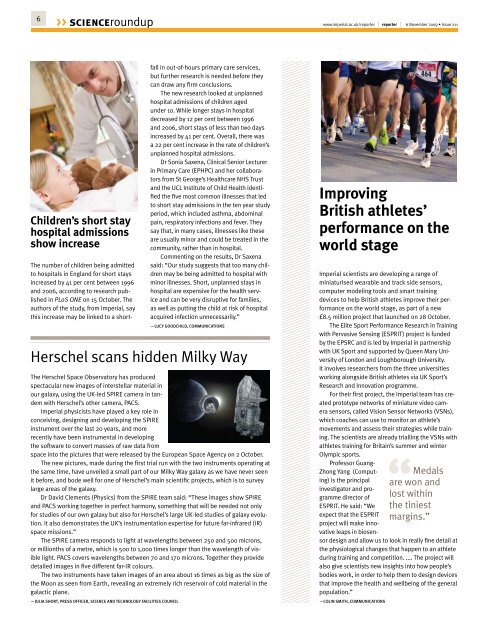211 pdf - Imperial College London
211 pdf - Imperial College London
211 pdf - Imperial College London
You also want an ePaper? Increase the reach of your titles
YUMPU automatically turns print PDFs into web optimized ePapers that Google loves.
6<br />
>> scienceroundup www.imperial.ac.uk/reporter | reporter | 6 November 2009 • Issue <strong>211</strong><br />
Children’s short stay<br />
hospital admissions<br />
show increase<br />
The number of children being admitted<br />
to hospitals in England for short stays<br />
increased by 41 per cent between 1996<br />
and 2006, according to research published<br />
in PLoS ONE on 15 October. The<br />
authors of the study, from <strong>Imperial</strong>, say<br />
this increase may be linked to a short-<br />
The Herschel Space Observatory has produced<br />
spectacular new images of interstellar material in<br />
our galaxy, using the UK-led SPIRE camera in tandem<br />
with Herschel’s other camera, PACS.<br />
<strong>Imperial</strong> physicists have played a key role in<br />
conceiving, designing and developing the SPIRE<br />
instrument over the last 20 years, and more<br />
recently have been instrumental in developing<br />
the software to convert masses of raw data from<br />
space into the pictures that were released by the European Space Agency on 2 October.<br />
The new pictures, made during the first trial run with the two instruments operating at<br />
the same time, have unveiled a small part of our Milky Way galaxy as we have never seen<br />
it before, and bode well for one of Herschel’s main scientific projects, which is to survey<br />
large areas of the galaxy.<br />
Dr David Clements (Physics) from the SPIRE team said: “These images show SPIRE<br />
and PACS working together in perfect harmony, something that will be needed not only<br />
for studies of our own galaxy but also for Herschel’s large UK-led studies of galaxy evolution.<br />
It also demonstrates the UK’s instrumentation expertise for future far-infrared (IR)<br />
space missions.”<br />
The SPIRE camera responds to light at wavelengths between 250 and 500 microns,<br />
or millionths of a metre, which is 500 to 1,000 times longer than the wavelength of visible<br />
light. PACS covers wavelengths between 70 and 170 microns. Together they provide<br />
detailed images in five different far-IR colours.<br />
The two instruments have taken images of an area about 16 times as big as the size of<br />
the Moon as seen from Earth, revealing an extremely rich reservoir of cold material in the<br />
galactic plane.<br />
—Julia Short, Press Officer, Science and Technology Facilities Council<br />
fall in out-of-hours primary care services,<br />
but further research is needed before they<br />
can draw any firm conclusions.<br />
The new research looked at unplanned<br />
hospital admissions of children aged<br />
under 10. While longer stays in hospital<br />
decreased by 12 per cent between 1996<br />
and 2006, short stays of less than two days<br />
increased by 41 per cent. Overall, there was<br />
a 22 per cent increase in the rate of children’s<br />
unplanned hospital admissions.<br />
Dr Sonia Saxena, Clinical Senior Lecturer<br />
in Primary Care (EPHPC) and her collaborators<br />
from St George’s Healthcare NHS Trust<br />
and the UCL Institute of Child Health identified<br />
the five most common illnesses that led<br />
to short stay admissions in the ten year study<br />
period, which included asthma, abdominal<br />
pain, respiratory infections and fever. They<br />
say that, in many cases, illnesses like these<br />
are usually minor and could be treated in the<br />
community, rather than in hospital.<br />
Commenting on the results, Dr Saxena<br />
said: “Our study suggests that too many children<br />
may be being admitted to hospital with<br />
minor illnesses. Short, unplanned stays in<br />
hospital are expensive for the health service<br />
and can be very disruptive for families,<br />
as well as putting the child at risk of hospital<br />
acquired infection unnecessarily.”<br />
—Lucy Goodchild, Communications<br />
Herschel scans hidden Milky Way<br />
Improving<br />
British athletes’<br />
performance on the<br />
world stage<br />
<strong>Imperial</strong> scientists are developing a range of<br />
miniaturised wearable and track side sensors,<br />
computer modeling tools and smart training<br />
devices to help British athletes improve their performance<br />
on the world stage, as part of a new<br />
£8.5 million project that launched on 28 October.<br />
The Elite Sport Performance Research in Training<br />
with Pervasive Sensing (ESPRIT) project is funded<br />
by the EPSRC and is led by <strong>Imperial</strong> in partnership<br />
with UK Sport and supported by Queen Mary University<br />
of <strong>London</strong> and Loughborough University.<br />
It involves researchers from the three universities<br />
working alongside British athletes via UK Sport’s<br />
Research and Innovation programme.<br />
For their first project, the <strong>Imperial</strong> team has created<br />
prototype networks of miniature video camera<br />
sensors, called Vision Sensor Networks (VSNs),<br />
which coaches can use to monitor an athlete’s<br />
movements and assess their strategies while training.<br />
The scientists are already trialling the VSNs with<br />
athletes training for Britain’s summer and winter<br />
Olympic sports.<br />
Professor Guang-<br />
Zhong Yang (Computing)<br />
is the principal<br />
investigator and programme<br />
director of<br />
ESPRIT. He said: “We<br />
expect that the ESPRIT<br />
project will make innovative<br />
leaps in biosensor<br />
design and allow us to look in really fine detail at<br />
the physiological changes that happen to an athlete<br />
during training and competition. .... The project will<br />
also give scientists new insights into how people’s<br />
bodies work, in order to help them to design devices<br />
that improve the health and wellbeing of the general<br />
population.”<br />
—Colin Smith, Communications<br />
Medals<br />
are won and<br />
lost within<br />
the tiniest<br />
margins.”

















